

The cosmic infrared background. (Phys.org) -- The cosmic infrared background is the collective infrared radiation emitted by cosmic sources throughout the history of the universe, including sources inaccessible to current telescopes.

The latter category, for example, includes the very first generation of stars, currently a subject of intense investigations. Because of the relative uniformity of this background, which is faint and might be interpreted as instrumental noise, fluctuations in it can often be more readily discerned than the actual background level itself. This property also lets astronomers discriminate against the significant foreground contributions from the solar system and our galaxy. CfA astronomers Matt Ashby and Giovanni Fazio joined with four colleagues to use the superb sensitivity and stability of the Infrared Array Camera (IRAC) on the Spitzer Space Telescope to probe the cosmic infrared background. Explore further: Computers beat brainpower when it comes to counting stars. HBj7E.jpg (JPEG Image, 3850×1925 pixels) - Scaled (26. Giant fractals are out – the universe is a big smoothie - space - 24 August 2012. Fractals are beautiful, but we wouldn't want to live in one.
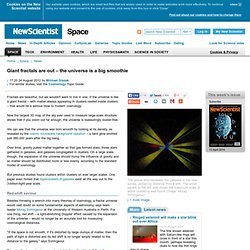
If the universe is like a giant fractal – with matter always appearing in clusters nested inside clusters – that would be a serious blow to modern cosmology. Now the largest 3D map of the sky ever used to measure large-scale structure shows that if you zoom out far enough, the universe is reassuringly cluster-free. We can see that the universe was born smooth by looking at its density, as revealed by the cosmic microwave background radiation – a faint glow emitted just 380,000 years after the big bang. Over time, gravity pulled matter together so that gas formed stars, those stars gathered in galaxies, and galaxies congregated in clusters. Hunt for dark matter closes in at Large Hadron Collider.
Physicists are closer than ever to finding the source of the Universe's mysterious dark matter, following a better than expected year of research at the Compact Muon Solenoid particle detector, part of the Large Hadron Collider at CERN in Geneva.
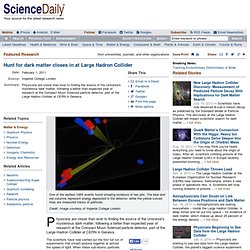
The scientists have now carried out the first full run of experiments that smash protons together at almost the speed of light. When these sub-atomic particles collide at the heart of the CMS detector, the resultant energies and densities are similar to those that were present in the first instants of the Universe, immediately after the Big Bang some 13.7 billion years ago. The unique conditions created by these collisions can lead to the production of new particles that would have existed in those early instants and have since disappeared. Cosmic microwave background radiation. Electromagnetic radiation as a remnant from an early stage of the universe in Big Bang cosmology The cosmic microwave background (CMB, CMBR), in Big Bang cosmology, is electromagnetic radiation as a remnant from an early stage of the universe, also known as "relic radiation".

The CMB is faint cosmic background radiation filling all space. It is an important source of data on the early universe because it is the oldest electromagnetic radiation in the universe, dating to the epoch of recombination. With a traditional optical telescope, the space between stars and galaxies (the background) is completely dark. However, a sufficiently sensitive radio telescope shows a faint background noise, or glow, almost isotropic, that is not associated with any star, galaxy, or other object. Physicists May Have Evidence Universe Is A Computer Simulation. Physicists say they may have evidence that the universe is a computer simulation.
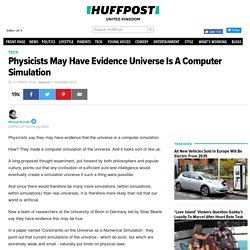
How? They made a computer simulation of the universe. And it looks sort of like us. A long-proposed thought experiment, put forward by both philosophers and popular culture, points out that any civilisation of sufficient size and intelligence would eventually create a simulation universe if such a thing were possible. And since there would therefore be many more simulations (within simulations, within simulations) than real universes, it is therefore more likely than not that our world is artificial. WMAP CMB Fluctuations. Scientists predict the next big thing in particle physics: Supersymmetry. A better understanding of the universe will be the outgrowth of the discovery of the Higgs boson, according to a team of University of Oklahoma researchers.
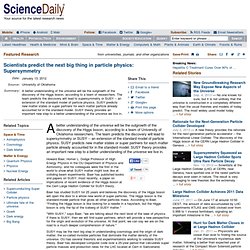
The team predicts the discovery will lead to supersymmetry or SUSY -- an extension of the standard model of particle physics. SUSY predicts new matter states or super partners for each matter particle already accounted for in the standard model. SUSY theory provides an important new step to a better understanding of the universe we live in. Howard Baer, Homer L. Big Bang theory challenged by big chill. The start of the Universe should be modeled not as a Big Bang but more like water freezing into ice, according to a team of theoretical physicists at the University of Melbourne and RMIT University.

They have suggested that by investigating the cracks and crevices common to all crystals -- including ice -- our understanding of the nature of the Universe could be revolutionized. Lead researcher on the project, James Quach said current theorizing is the latest in a long quest by humans to understand the origins and nature of the Universe. "Ancient Greek philosophers wondered what matter was made of: was it made of a continuous substance or was it made of individual atoms? " he said. "With very powerful microscopes, we now know that matter is made of atoms.
" "Thousands of years later, Albert Einstein assumed that space and time were continuous and flowed smoothly, but we now believe that this assumption may not be valid at very small scales. Could the Higgs boson explain the size of the universe? The Universe wouldn't be the same without the Higgs boson.

This legendary particle plays a role in cosmology and reveals the possible existence of another closely related particle. Quark matter’s connection with the Higgs: Heavy ion collisions delve deeper into the origin of (visible) mass. You may think you've heard everything you need to know about the origin of mass.

After all, scientists colliding protons at the Large Hadron Collider (LHC) in Europe recently presented stunning evidence strongly suggesting the existence of a long-sought particle called the Higgs boson, thought to "impart mass to matter. " But while the Higgs particle may be responsible for the mass of fundamental particles such as quarks, quarks alone can't account for the mass of most of the visible matter in the universe -- that's everything we see and sense around us.
To get a grasp on what holds these visible forms of matter together -- everything from stars to planets to people -- you have to understand how quarks and gluons interact. That's the essence of quark matter physics -- and the Quark Matter 2012 international conference, taking place in Washington, D.C., August 12-18. Mathematicians can conjure matter waves inside an invisible hat. Invisibility, once the subject of magic or legend, is slowly becoming reality.
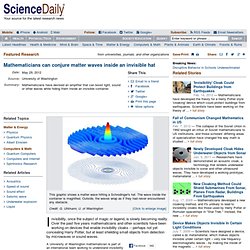
Over the past five years mathematicians and other scientists have been working on devices that enable invisibility cloaks -- perhaps not yet concealing Harry Potter, but at least shielding small objects from detection by microwaves or sound waves. A University of Washington mathematician is part of an international team working to understand invisibility and extend its possible applications. The group has now devised an amplifier that can boost light, sound or other waves while hiding them inside an invisible container. "You can isolate and magnify what you want to see, and make the rest invisible," said corresponding author Gunther Uhlmann, a UW mathematics professor. The birth of time: Quantum loops describe the evolution of the Universe.